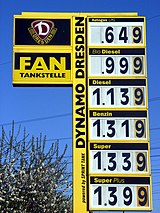
Back Precio de la gasolina y del diésel Spanish Marché du carburant French מחיר הדלק HE การใช้และการตั้งราคาแก๊สโซลีนและน้ำมันดีเซล Thai בענזין פרייזן YI
This article needs to be updated. (March 2022) |
This section needs additional citations for verification. (April 2022) |

The usage and pricing of gasoline (or petrol) results from factors such as crude oil prices, processing and distribution costs, local demand, the strength of local currencies, local taxation, and the availability of local sources of gasoline (supply). Since fuels are traded worldwide, the trade prices are similar. The price paid by consumers largely reflects national pricing policy. Most countries impose taxes on gasoline (petrol), which causes air pollution and climate change; whereas a few, such as Venezuela, subsidize the cost.[1] Some country's taxes do not cover all the negative externalities, that is they do not make the polluter pay the full cost.[2][3][4] Western countries have among the highest usage rates per person. The largest consumer is the United States.[5]
- ^ Deutsche Gesellschaft für Internationale Zusammenarbeit (German Agency for International Cooperation). "International Fuel Prices 2010/11" (PDF). Archived from the original (PDF) on 12 May 2013. Retrieved 27 March 2013.
- ^ "Fossil fuel costs must include externalities". The Statesman. 4 March 2021. Retrieved 14 April 2021.
- ^ Environment, U. N. (1 December 2020). "Emissions Gap Report 2020". UNEP - UN Environment Programme. Retrieved 14 April 2021.
- ^ Bhalla, Jag (24 February 2021). "What's your "fair share" of carbon emissions? You're probably blowing way past it". Vox. Retrieved 14 April 2021.
- ^ Fueling America: A Snapshot of Key Facts and Figures Archived 2012-06-08 at the Wayback Machine Retrieved 7 August 2012
© MMXXIII Rich X Search. We shall prevail. All rights reserved. Rich X Search